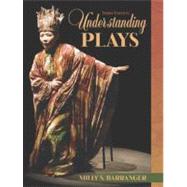
Note: Supplemental materials are not guaranteed with Rental or Used book purchases.
Purchase Benefits
What is included with this book?
Preface.
I. Introduction.
1. From Text to Performance.
Drama and Performance.
Dramaturgy.
Dramas Stages.
Dramatic Time.
Dramas Landscapes.
Dramas Meanings and Messages.
Critics Notebook.
Re-Visiting Drama and Performance.
Photo.
II. Elements of Drama.
2. Understanding Play Structure.
Dramas Special Mirrors.
Climactic Play Structure.
Episodic Play Structure.
Situational Play Structure.
Reflexive Structure.
The Tragedy of Hamlet Prince of Denmark, William Shakespeare.
Performing Hamlet.
Critics Notebook.
Re-Visiting Play Structure.
Photo: Peter Brooks Hamlet at Brooklyn Academy of Music.
3. Understanding Character.
Characters Doubleness.
Classical versus Modern Characters.
Observing Character-in-Action.
A Common Humanity.
Darwin, Marx, and Freud.
“Whos There?”
Postmodern Dissolution.
The Glass Menagerie, Tennessee Williams.
Performing The Glass Menagerie.
Critics Notebook.
Re-Visiting Dramatic Character.
Photo.
4. Understanding Language.
The Verbal Text.
Language as Organization.
Conventions of Stage Language.
The Cherry Orchard, Anton Chekhov.
Performing The Cherry Orchard.
Critics Notebook.
Re-Visiting Stage Language.
Photo.
III. Types of Dramatic Writing
5. Tragedy.
Origins of Theater and Drama.
Aristotles Definitions.
Dramas Elements and Conventions.
Theories of Tragedy.
Oedipus the King, Sophocles.
Performing Oedipus the King.
Critics Notebook.
Re-Visiting Greek Tragedy.
Photo: Smetana theater/Josef Svoboda Production, Prague.*
6. Comedy.
Origins of Comedy.
Theories of Comedy.
English Comedy and Neoclassical Theory.
The Comedy of Manners.
The Importance of Being Earnest, Oscar Wilde.
Performing The Importance of Being Earnest.
Critics Notebook.
Re-Visiting High Comedy.
Photo.
7. Farce and Satire.
Background.
Farce and Comedy.
Satire and Society.
The Colored Museum, George C.Wolfe.
Performing The Colored Museum.
Critics Notebook.
Revisiting Farce and Satire.
Photo: The Colored Museum, NY Shakespeare Festival Production.*
8. Tragicomedy and New Forms.
The Mixed Genre.
Modern Tragicomedy.
Angels in America Part One: Millennium Approaches, Tony Kushner.
Performing Angels in America.
Critics Notebook.
Re-Visiting Drama and Society.
Photo. @PARTHEAD = IV. Understanding Modern Writing Styles.
9. Understanding Modernism.
Background.
Fragmentation.
Modernist Theory.
Hedda Gabler, Henrik Ibsen.
Performing Hedda Gabler.
Critics Notebook.
Re-Visiting Modernism.
Photo: Kate Burton in Hedda Gabler, Broadway, 2001.
10. Understanding Modern Realism.
Observations on the Ordinary
The “New” Dramatic Text
The Photographic Landscape
Naturalisms “Case Studies.”
The Well-Made Play.
Fences, August Wilson.
Performing Fences.
Critics Notebook.
Re-Visiting Modern Realism.
Photo: James Earl Jones in Fences, Yale Repertory Theatre.*
V. Understanding Theatricalism.
11. Understanding Theatricalism and Epic Theater.
The Stage as Platform.
Epic Theory & Practice.
Epic Techniques.
Galileo, Bertolt Brecht.
Performing Galileo.
Critics Notebook.
Re-visiting Epic Theater.
Photo: Brian Dennehy as Galileo in Goodman Theatre Production.*
12. Understanding Minimalism and the Absurd.
Background.
Absurdist Theory.
The Stage as Existential Void.
Footfalls, Samuel Beckett.
Performing Footfalls.
Critics Notebook.
Photo: Billie Whitelaw in Samuel Beckett Theatre production of Footfalls.*
VI. Playwriting at the Millennium
13. Understanding Feminist Drama and Performance.
Gender, Art, and Politics.
Feminist Theory.
Feminist Play Structure.
How I Learned to Drive, Paula Vogel.
Performing How I Learned to Drive.
Critics Notebook.
Re-Visiting Feminist Theatre.
Photo: Mary Louise Parker in How I Learned to Drive, Off Broadway.
14. Understanding the “New” Docudrama.
Reconstructing Modern History in the Epic Style.
The “Living Newspaper.”
The “New” Documentary Play.
The Laramie Project, Moiss Kaufman.
Performing The Laramie Project.
Critics Notebook.
Revisiting Documentary Theater.
Photo.
15. Understanding the Solo Performance Text.
Performance: A Definition in Three Keys.
Performance Art.
Solo Performance: Theory & Practice.
Shaping the Solo Performance Text.
Of Mice, Bugs and Women (The Secaucas Monologue), Deb Margolin.
Performing The Secaucas Monologue.
Critics Notebook.
Re-Visiting Performance Art.
Photo: Deb Margolin in Performance.
16. Understanding Interculturalism.
Background.
The Intercultural Text.
U.S. Hispanic and Latino/Latina Playwriting.
Broken Eggs, Eduardo Machado.
Performing Broken Eggs.
Critics Notebook.
Photo: Production of Broken Eggs, Repertorio Espanol, Off Broadway.*
Asian-American Playwriting
Golden Child, David Henry Hwang
Performing Golden Child.
Critics Notebook: On Asian-American Drama
Re-Visiting Interculturalism.
Photo: Production of Golden Child, East West Players, 2000.
Appendix.
Play Analysis and Conceptualization: A Process, by Gayle M. Austin
List of Critical Terms.
Selected Readings.
Related Film, Video (DVD), and Web Site Resources.
Index.
The New copy of this book will include any supplemental materials advertised. Please check the title of the book to determine if it should include any access cards, study guides, lab manuals, CDs, etc.
The Used, Rental and eBook copies of this book are not guaranteed to include any supplemental materials. Typically, only the book itself is included. This is true even if the title states it includes any access cards, study guides, lab manuals, CDs, etc.